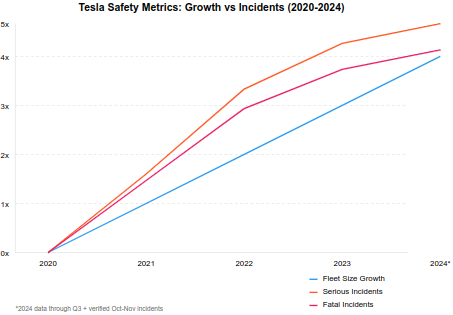A recent Florida court ruling in the Banner case stated there was “no evidence Tesla should’ve known Autopilot features were likely to kill or maim.” This conclusion defies reality and mocks the families of over 50 people who have died in Tesla Autopilot-related crashes since 2016.
The Evidence is Clear
Tesla has known about Autopilot’s fatal flaws from the beginning:
- The first death occurred in January 2016 in China when Gao Yaning’s Model S crashed into a street sweeper
- Months later, Joshua Brown became the first American casualty when his Tesla drove under a semi-truck
- These deaths weren’t anomalies – they were the start of a pattern that has continued for eight years
Tesla Stands Alone
No other manufacturer with similar technology has such a deadly record:
- Leaders in autonomous driving GM, Mercedes, Nissan, and Volvo haven’t accumulated dozens of deaths with their driver assistance systems
- Only Tesla vehicles regularly fail to detect cross-traffic and emergency vehicles parked on highways
Internal Knowledge vs. Public Claims
- Tesla’s own engineers have testified about the disconnect between internal knowledge and public marketing
- While promoting “Full Self-Driving,” internal documents showed engineers were aware of critical limitations
- The company continued pushing capabilities they knew were dangerous
Safety Compromises
- Tesla has repeatedly removed safety features like radar and ultrasonic sensors for cheaper camera-only systems
- Internal safety projects were scrapped and restarted, losing critical knowledge
- Their engineering patterns are so problematic that incident rates increase after attempted recalls
Documented Pattern of Failure

The data clearly shows both serious incidents and fatal incidents increasing faster than fleet size growth. This pattern is so evident, so obvious, the federalist judges clearly are wrong about a trivial prediction of harms.
Deaths Exceed Domestic Vehicle Terrorism

Tesla Autopilot-related deaths now exceed those from domestic terrorism involving vehicles.
A Failed Justice System
This ruling isn’t just incorrect – it insults the families of Pablo Teodoro III, Walter Huang, Naibel Leon, Jeffrey Nissen, and dozens of others who died because Tesla prioritized fraud, documented fraud, over safety. It puts more lives at risk and demonstrates how our justice system has failed to hold Elon Musk accountable.
If eight years of documented engineering failures, dozens of fatalities with similar characteristics, and whistleblower testimonies don’t meet the threshold for “should have known,” then what possibly could?

